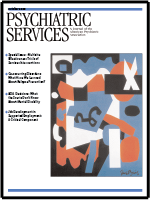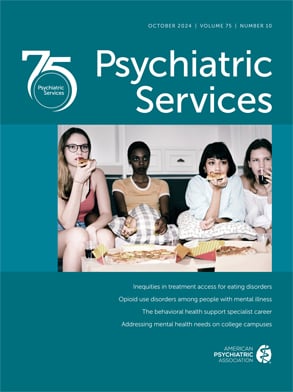To the Editor: I read with interest the special section in the September issue on the use of seclusion and restraint in psychiatric treatment settings. Physical restraint—the holding of an individual by staff to contain dangerous behavior—is used at many different levels of care, from hospitals and residential facilities to group homes and schools, especially with children and adolescents (
1,
2).
Unpublished data for 1995 to 2004 from the Joint Commission on Accreditation of Healthcare Organizations (JCAHO) indicate that among 3,000 sentinel events that involved severe injury or death, 115 restraint-related fatalities occurred. Fourteen percent of the restraint-related deaths involved "take-down and hold" maneuvers. Death resulted from asphyxia because of inability to expand the chest or from obstruction of the airway, usually with a face towel to prevent spitting or biting (personal communication, Croteau R, 2005). A JCAHO study of 20 restraint-related deaths found that chest compression had limited the patients' air exchange, which led to inadequate oxygenation (
3). Similar problems have been noted for sitting restraints, such as the basket hold.
Currently, when a person is restrained, adequacy of oxygenation is assessed through pulse, blood pressure, and respiration measurements, which are confounded by anxiety and anger. Pulse oximetry is a noninvasive direct measure of oxygenation that has been used in medical facilities to measure the oxygen saturation of hemoglobin. Portable oximeters are accurate and reliable (
4).
To determine the usefulness of pulse oximetry during restraint procedures, baseline pulse oximetry readings were obtained for all patients at our residential treatment facility, which has an average daily census of 84. The residents were given information by a licensed practical nurse about the use of pulse oximetry readings to decrease the possibility of suffocation during restraint. Residents included male and female adolescents aged 12 to 18 years who had psychiatric and behavior problems and who lived in seven separate units in the facility.
Oxygen saturation was measured during 31 physical restraint episodes (12 patients) over 70 days (March 10 to May 19, 2005) by using a probe from a portable oximeter that was clipped to a finger or toe (
2) by licensed practical nurses. The oximeter used was the 503 DX model from Criticare Systems Mini SPO2T. In seven of the restraint episodes, the patients were prone; in the remainder, the patients were in standing positions. The mean±SD duration of an individual episode was 9±6 minutes.
Baseline oxygen saturation readings were 96 percent or greater; readings during restraint episodes were 95 percent or greater. No incidents of respiratory distress were noted either by the staff or by the residents during restraint. Oximetry was well accepted by staff and patients. In fact, we found that placing the finger probe on the adolescent's hand and asking him or her to turn on the oximeter, if interested, sometimes distracted everyone involved, diffused tension, and ended the restraint.
It will be necessary to see how oximetry performs under conditions of impaired oxygenation. There is concern that it might give an inaccurate reading during acute dyspnea, making repeat readings and clinical correlation essential (
4). In addition, in one study when volunteer staff of a mental health facility were restrained in either a prone or a supine position and then directed to exercise, those subjected to prone restraint showed prolonged pulse recovery after exercise, which may suggest a link with sudden death during prone restraint (
5). Although the oximetry measures for the volunteers did not show abnormalities, measurements during clinical situations could help clarify any role that oxygenation plays in pulse abnormalities.
Our investigations suggest that oximetry in medical settings, such as hospitals, and nonmedical settings, such as group homes, may be a viable, cost-effective tool that could protect persons who are subjected to physical restraint from respiratory embarrassment, suffocation, and death.

